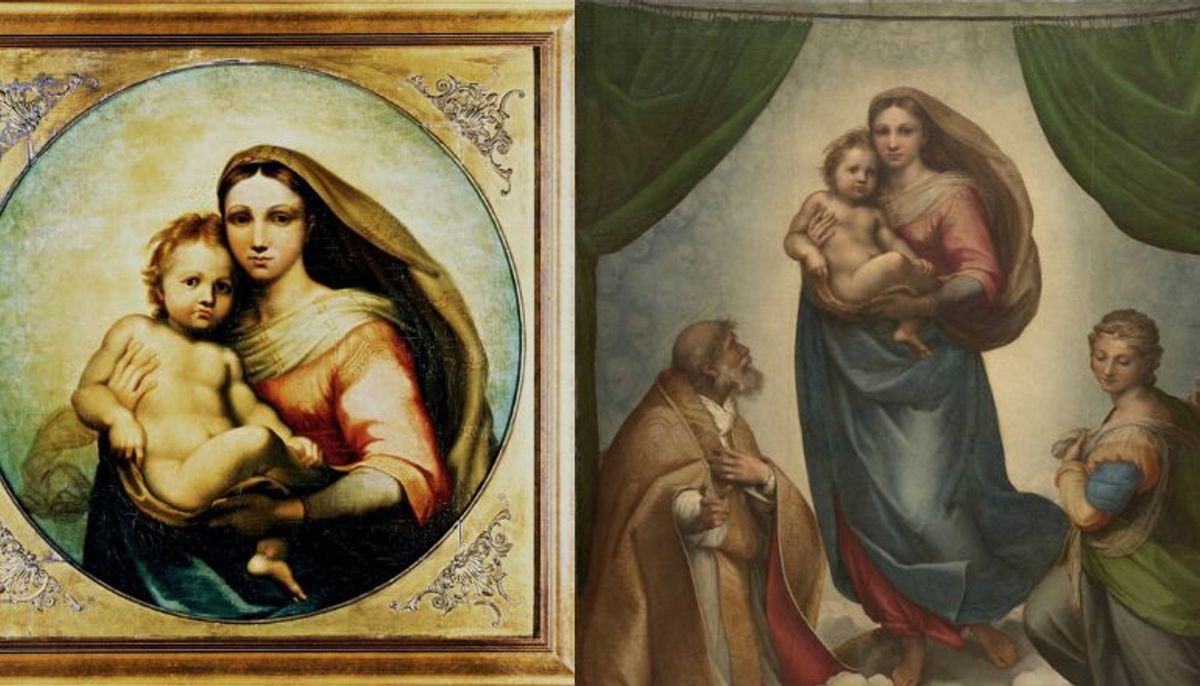Old Masters experts have questioned a painting newly attributed to Raphael via an artificial intelligence programme. Earlier this year, an analysis by two UK universities using AI-assisted, computer-based facial recognition showed that the faces in the work known as the de Brécy Tondo were identical to those in Raphael’s masterpiece, the Sistine Madonna (around 1513). The de Brécy Tondo is now on show at Bradford’s Cartwright Hall Art Gallery in the UK, the first time it has gone on public display.
In January, research teams from the University of Bradford and the University of Nottingham said that they had used new facial recognition technology to examine the de Brécy Tondo, comparing the faces in the work to those in the Sistine Madonna. The Madonnas depicted in each painting had a 97% similarity, while the infant shown in each had an 86% similarity (a rating above 75% is considered identical according to the study).
Angelamaria Aceto, researcher in Italian drawings at the Ashmolean Museum in Oxford, tells The Art Newspaper: “I have never seen the piece in person but judging from the photograph it would appear to be a copy after Raphael. While I am always open to the use of new technologies and approaches, I would not support an assessment of authenticity that relies on AI. True connoisseurship relates to the expert judgment of the trained eye and is so much more than mechanically matching brushstrokes and images.”
Bendor Grosvenor, an art historian and a columnist at The Art Newspaper, says: “This story is so perfectly AI; it can’t tell what’s real or not, and nor can the media reporting it. One phone call to any half decent Raphael scholar is all they needed. The only way we, that is humanity, will be able to compete with the AI challenge is to think critically.”
Meanwhile, another Raphael specialist who preferred to remain anonymous tells us: “The picture is clearly a copy from the 19th century. It’s not strange that the facial features match the original because it was copied after it.”
Hassan Ugail, the director of the centre of visual computing at the university of Bradford, told The Guardian: “Testing the Tondo using this new AI model has shown startling results, confirming it is most likely by Raphael. Together with my previous work using facial recognition and combined with previous research by my fellow academics, we have concluded the Tondo and the Sistine Madonna are undoubtedly by the same artist.”
In response to the critics’ comments, Ugail tells The Art Newspaper: “Modern deep learning-assisted AI technology has indeed made significant advancements in recent years, allowing it to analyse images, including works of art, with an unprecedented level of detail. Contrary to the notion that AI merely identifies and compares similarities, it can actually go beyond that by examining subtle differences, for example brushstroke patterns, colours, hues, tonal values etc. This capacity enables AI to observe art works in greater detail than the naked eye, often revealing nuances that might be overlooked by human perception.
“It is essential to acknowledge that the expertise of art historians and scholars remains invaluable in understanding the historical and cultural context of artworks. However, incorporating AI into the process can provide additional insights and complementary information that enriches the overall assessment. Furthermore, AI can bring a further degree of transparency into the process, contributing to a clearer and more accountable approach to authentication.”
The collector and businessman George Lester Winward bought the de Brécy Tondo in 1981, which was assumed to be a copy of a work by Raphael made in the Victorian era. According to the Smithsonian magazine, Winward noticed that the painting resembled Raphael’s 1513 masterpiece, the Sistine Madonna. In 1995, Winward transferred ownership of his paintings collection to the new de Brécy Trust (which he founded) to further research on the tondo; Winward died in 1997.


